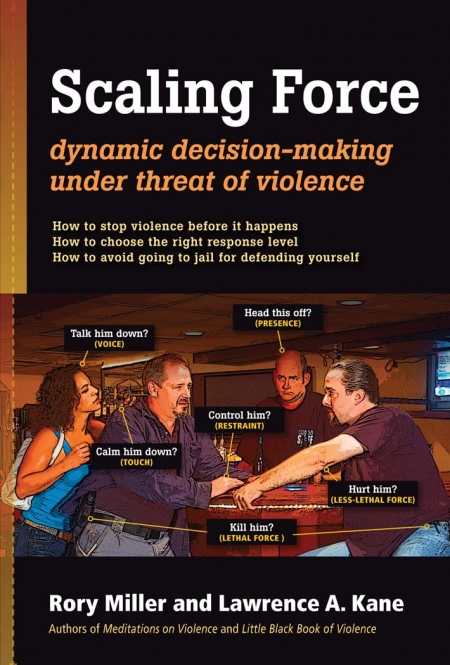Scaling Force
Dynamic Decision-Making Under Threat of Violence
- 2012 INDIES Finalist
- Finalist, Self-Help (Adult Nonfiction)
Miller and Kane show how techniques of handling potentially violent individuals can apply to a range of real situations.
Whether dealing with a belligerent drunk at a bar or facing down a potential mugger, surviving a fight with minimal damage can come down to effective preparation and making the right call under pressure. With Scaling Force: Dynamic Decision-Making Under Threat of Violence, Rory Miller and Lawrence A. Kane have crafted a thorough, practical guide to avoiding potentially dangerous situations and how to react with the right level of force when the “potentially” part disappears.
Both authors have decades of work experience dealing with violent individuals—Miller as a former corrections officer, Kane supervising security at a football stadium—and that shows in the variety of situations, tactics, and caveats they include throughout the book. Though it’s essentially a how-to manual, Miller and Kane made their work far more engaging by sharing anecdotes from their own experiences (and those of colleagues) and presenting hypothetical situations that genuinely transport the reader into that moment of considering the pros and cons of each option. A handful of sections might have too many anecdotes, but the majority of them work, showing how the techniques taught in the book can apply to a range of real situations and providing a welcome narrative component to what could have been a very matter-of-fact book.
Scaling Force is broken down into six levels of force, starting with how to use body language to make oneself a less-inviting target, therefore avoiding confrontation, and continuing all the way up to applying deadly force when an assailant leaves no other choice. The authors explain how to tell if a potential assailant may be carrying a weapon, how to best position one’s body when interacting with a stranger, how to use objects at hand as defensive weapons, and how to use the presence of witnesses to one’s advantage. The first few levels of force actually cover dozens of ways to prevent a situation from becoming violent, walking the reader through different ways to diffuse an argument with the right words or calm an emotionally disturbed or intoxicated individual.
As levels of force escalate, the authors stress the differences between even the best martial arts training and the practical realities of a real-world situation—where the attacker is not a willing participant in a test of skill or predisposed to a fair fight. Miller and Kane also consistently stress the legal ramifications of an individual’s actions in a fight situation, and the reality that what might seem to be a case of self-defense in the moment can easily become a criminal conviction, even when using nonlethal force.
The authors provide a lot to think about, and Scaling Force is a useful tool that will help readers better think on their feet when they truly must.
Reviewed by
Jeff Fleischer
Disclosure: This article is not an endorsement, but a review. The publisher of this book provided free copies of the book and paid a small fee to have their book reviewed by a professional reviewer. Foreword Reviews and Clarion Reviews make no guarantee that the publisher will receive a positive review. Foreword Magazine, Inc. is disclosing this in accordance with the Federal Trade Commission’s 16 CFR, Part 255.

